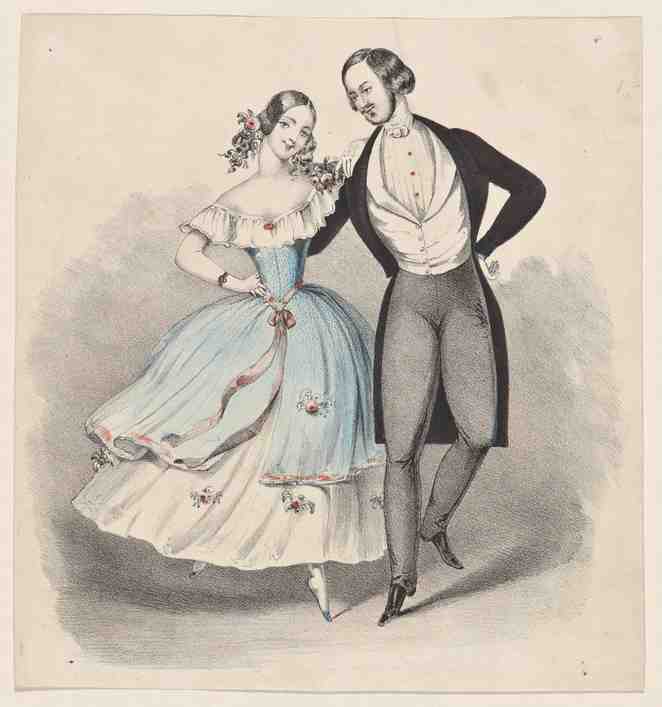
History of Polka Dance and Music
Polka is defined as a vivacious couple dance of Bohemian origin in duple time; has a basic pattern of hop-step-close-step; a lively Bohemian dance tune in 2/4 time.
The polka was originally a Czech peasant dance, developed in Eastern Bohemia (now part of the Czech Republic).
Bohemian historians believe that the polka was invented by a peasant girl (Anna Slezak, in Labska Tynice in 1834) one Sunday for her amusement. It was composed to a folk song "Strycek Nimra Koupil Simla (Uncle Nimra brought a white horse)." Anna called the step "Madera" because of its quickness and liveliness.
The dance was first introduced into the ballrooms of Prague in 1835. The name of the dance (pulka) is Czech for "half-step", referring to the rapid shift from one foot to the other.
In 1840, Raab, a dance teacher from Prague, danced the polka at the Odeon Theatre in Paris where it was a tremendous success. Parisian dancing teachers seized on the new dance and refined it for their salons and ballrooms.
According to Cellarius, the famous French dancing master of the mid-nineteenth century: "What young man is there, although formerly most opposed to dancing, whom the polka has not snatched from his apathy to acquire, willy-nilly, a talent suddenly become indispensable?"
Polkamania resulted. Dance academies were swamped and in desperation recruited ballet girls from the Paris Opera as dancing partners to help teach the polka. This naturally attracted many young men who were interested in things other than dancing, and manners and morals in the dance pavilions deteriorated. Dancing developed a bad name and many parents forbade their daughters dancing with any but close friends of the family.
The polka was introduced in England by the middle of the nineteenth century. However, it did not achieve the popularity it had achieved on the Continent. By this time, it had also reached the United States. Thomas Balch, in his book Philadelphia Assemblies, reports that Breiter's band composed a new polka for the occasion of the 1849 Assembly. It was evident the waltz and polka were gradually replacing the contredanse and cotillion.
The popularity of the polka led to the introduction of several other dances from central Europe. The simplest was the galop or galoppade which was introduced into England and France in 1829. Dance position was the same as for the waltz or polka, with couples doing a series of fast chassés about the room with occasional turns. Music was in 2/4 time, often merely a fast polka. The galop was particularly popular as the final dance of the evening.
The polonaise, named for its country of origin, was a stately processional march in slow ¾ time, often used for the opening of a fancy dress ball. However, it never achieved great popularity as a ballroom dance. The Bohemian redowa consisted of three successive movements: a "pursuit" step, an ordinary waltz step, and a valse à deux temps step. It was danced to a slow waltz. The Polish mazurka, a fairly complicated dance to waltz music, included hops, sliding steps, and kicking the heels together. The schottische was a German folk dance that consisted of a series of chassés and hops done to 2/4 and 4/4 music. There were also combination dances such as the polka-redowa and polka-mazurka.
Of all the dances originating in the nineteenth-century, the only one that has survived is the polka. After the initial enthusiasm, the polka gradually declined in popularity and reached a low point with the introduction of ragtime, jazz, and the newer dances of the early twentieth century. After the second world war, however, Polish immigrants to the United States adopted the polka as their "national" dance. It is also extremely popular with many other Americans who have succumbed to the new polka craze popularized by Lawrence Welk and other post-war bands.
For years to come, the polka will remain popular, with its variance in style from robust to smooth short, glide steps and ever happy music. One of the most popular versions of the polka is the "heel and toe and away we go" due to its ease to execute.
Polka Music
The Beer Barrel Polka, also known as Roll Out the Barrel (German version Rosamunde) is a popular polka song. It is played at many weddings and social dance evenings.
André Rieu & Heino performing 'Rosamunde' live in his hometown Maastricht on YouTube.
Beer Barrel Polka - Walter Ostanek - Canada's Polka King on YouTube.
Polka is a popular dance in the country western sector. Polkas and schottische are competitive Country Western dances.
Previous in History: Peabody
Next in History: Rumba